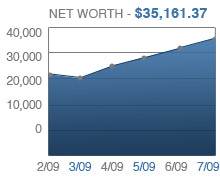 Today we are headed to California on vacation for a week. Keep checking back as I am trying to get a couple guest writers from people who have inspired me to work hard and to be smart with money. I wrote a couple of post last night so that I can be posting through next week.
Today we are headed to California on vacation for a week. Keep checking back as I am trying to get a couple guest writers from people who have inspired me to work hard and to be smart with money. I wrote a couple of post last night so that I can be posting through next week.In the meantime, here is 10 Reasons to be a Long-term Bull that I got in my last Edward Jones statement. Here is a link to the whole PDF.
1. The economy is bruised, but it’s not broken. Last year, the value of all goods and services produced in the United States (gross domestic product, or GDP) was $14 trillion. Americans earned $10 trillion in disposable income.
2. It’s not the Great Depression. Though many people like to compare today to the Great Depression, there hasn’t been a run on the banks. There are no widespread bread lines or soup kitchens.
3. Debt/deficits won’t crush the economy. Currently, the deficit is expected to be no higher than 15% – which is the highest since 1943. If you’re concerned that higher taxes may be imposed to pay for higher spending, consider investments that could help reduce future tax payments.
4. 50% drops historically have been an opportunity.
5. The government continues to support the financial system. While support for banks is controversial (and expensive), it’s designed to prevent the widespread panic and bank runs that occurred during the Great Depression. The Fed will continue to do more to support the credit markets and the economy, entering the market directly when necessary to lower mortgage and other rates if necessary.
6. Stock valuation is compelling. By almost any traditional measure of value, stocks have already priced in a lot of the bad economic news.
7. Inflation is under control. The Fed is keeping a close eye on inflation. However, if inflation does increase from its current level near zero to 2% – 3%, that’s probably a better scenario than deflation, or falling prices, which is a much tougher situation from which to recover.
8. When you feel bad, it can be good. High levels of fear and anxiety, which is often seen after the market has done most of its damage.
9. Good performance often follows bad. There have been only three negative 10-year periods since 1926, but the 10 years ended Dec. 31, 2008, were the worst (-1.4% per year). However, historically, good years have often followed bad ones. In each of the 12 10-year periods following those 10-year periods when market returns were less than 6%, the returns have averaged about 13%.
10. You still have long-term goals you are trying to achieve. A $100 investment that has fallen to $60 has lost 40%, but that investment must now rise 66% to break even. This can be difficult to achieve if the money is no longer invested.
Have a great weekend and even better week!











nice, have fun over there! I LOVE Cali..
ReplyDelete